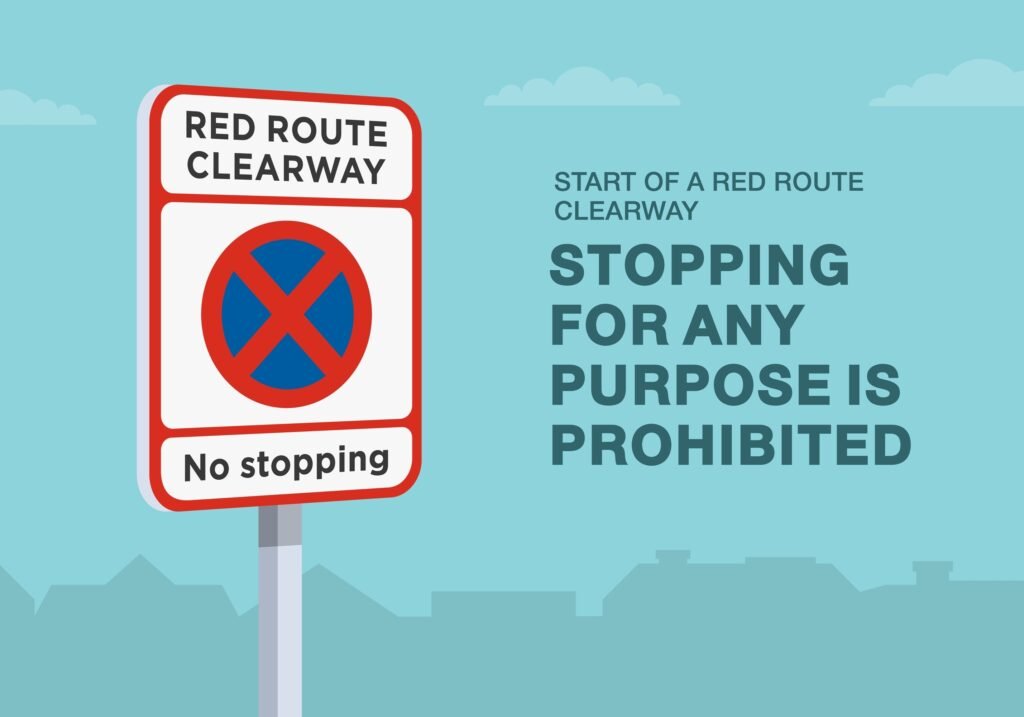No stopping

What Does “No Stopping” Really Mean?
Okay, let’s get straight to it. If you’re learning to drive, there’s one road rule that gives zero wiggle room: No Stopping.
This is not one of those “grey area” rules. It’s bold. It’s clear. And if you don’t respect it, the road — and your wallet — will remind you why it matters.

No Stopping = No Excuses
When you see the sign — a bold red circle with a blue background and a red cross — it’s a non-negotiable:
- You cannot stop your car, not even for a second.
- You can’t pick someone up.
- You can’t check your phone.
- You can’t “just quickly” drop something off.
The only exceptions?
- Traffic forces you to stop.
- A police officer directs you.
- Or, there’s an actual emergency.
Everything else? Nope. 🚫

No Stopping Sign Where You’ll Spot It
Think of places where stopping would cause chaos or danger — that’s where “No Stopping” shows up:
- Outside schools (those zig-zag yellow lines scream keep moving).
- On clearways (open stretches of road where traffic must flow).
- On red routes in cities like London, where congestion is the enemy.
If you stop there? You’re blocking, you’re delaying, you’re risking.
No Stopping vs. No Waiting vs. No Parking
Here’s where most learners trip up. Let’s break it down like a pro:
- No Stopping – You keep rolling. End of story.
- No Waiting – You can stop briefly for passengers, but you can’t hang around.
- No Parking – You can’t leave the car, but you might be allowed to load/unload.
Big takeaway? No Stopping is the strictest of them all.
No Stopping Sign What Happens If You Break It
The system does not mess around here. Stop where you shouldn’t and you could face:
- A Penalty Charge Notice (that’s money out of your pocket).
- Points on your licence.
- Or even towing.
And trust me, nobody wants their driving memories to include their car being dragged onto the back of a recovery truck.
No Stopping Sign – Pro Tips for Learners
- Train your eyes – The no stopping sign is easy to spot. Lock it into your brain.
- Respect the markings – Zig-zags, red lines, solid paint = keep rolling.
- Don’t rationalise – “It’s just a second” is how fines happen.
- Plan your journey – Need to stop? Choose safe, legal spots.
Importance of No Stopping Sign
Driving is about flow. It’s about rhythm. And “No Stopping” is all about protecting that. When you follow it, you’re not just avoiding a fine — you’re proving you’re a confident, responsible driver who understands how to share the road like a pro.
So next time you see that sign? Smile, nod, and keep moving. That’s the mark of someone who’s driving smart.
What are some tips for learners to understand and follow ‘No Stopping’ signs?
Learners should train their eyes to spot ‘No Stopping’ signs quickly, respect road markings like zig-zags and red lines, avoid rationalizing temporary stops, and plan their journeys to choose legal and safe stopping spots when necessary.
What are the consequences of breaking the ‘No Stopping’ rule?
Breaking the ‘No Stopping’ rule can result in penalties such as a Penalty Charge Notice (fine), points on your driving licence, or your vehicle being towed away. It’s important to obey these signs to avoid legal and financial penalties.
What is the difference between ‘No Stopping,’ ‘No Waiting,’ and ‘No Parking’?
‘No Stopping’ means your vehicle must keep moving and cannot stop at all. ‘No Waiting’ allows for brief stops, such as picking up or dropping off passengers, but not hanging around. ‘No Parking’ prohibits leaving the vehicle behind, though you might be allowed to load or unload in some cases. ‘No Stopping’ is the strictest of the three.
Where are ‘No Stopping’ signs typically placed and why?
‘No Stopping’ signs are usually placed where stopping could cause danger or chaos, such as outside schools, on clearways, and on red routes in cities like London, to ensure continuous traffic flow and safety.
What does the ‘No Stopping’ sign mean and what are its restrictions?
The ‘No Stopping’ sign means you are not allowed to stop your vehicle at all, not even briefly, except in cases like traffic forcing you to stop, police directing traffic, or an emergency. You cannot pick up or drop off passengers, check your phone, or make any brief stops when this sign is in effect.
Contents
- 1 No stopping
- 1.1 No Stopping = No Excuses
- 1.2 No Stopping Sign Where You’ll Spot It
- 1.3 No Stopping vs. No Waiting vs. No Parking
- 1.4 No Stopping Sign What Happens If You Break It
- 1.5 No Stopping Sign – Pro Tips for Learners
- 1.6 Importance of No Stopping Sign
- 1.6.1 What are some tips for learners to understand and follow ‘No Stopping’ signs?
- 1.6.2 What are the consequences of breaking the ‘No Stopping’ rule?
- 1.6.3 What is the difference between ‘No Stopping,’ ‘No Waiting,’ and ‘No Parking’?
- 1.6.4 Where are ‘No Stopping’ signs typically placed and why?
- 1.6.5 What does the ‘No Stopping’ sign mean and what are its restrictions?